中考复习初中英语动词时态归纳总结对照表
中考复习初中英语动词时态归纳总结对照表

初中英语动词时态归纳总结对照表初中英语时态专项练习1、一般现在时..通常用“usually; often; every day; sometimes”..一般现在时基本用法介绍一、一般现在时的功能1.表示事物或人物的特征、状态..如:The sky is blue.天空是蓝色的..2.表示经常性或习惯性的动作..如:I get up at six every day.我每天六点起床..3.表示客观现实..如:The earth goes around the sun.地球绕着太阳转..二、一般现在时的构成:肯定句:1.主语+系动词 beis; am; are +名词形容词;介词短语2 .其他主语+动词原形+其它第三人称单数+动词-s+其它如:I am a boy.我是一个男孩..We study English.我们学习英语..Mary likes Chinese.玛丽喜欢汉语..三、一般现在时的变化否定句: 1主语+ be is;am;are+ not +其它.. 如:He is not a worker.他不是工人..2其他主语+do notdon’t动词原形+其它 I don't like bread第三人称单数+does notdoesn’t动词原形+其它He doesn't often play.一般疑问句:1BeIs;Are +主语+其它如:-Are you a student -Yes. I am. / No; I'm not. 2Do其他主语+动词原形+其它Does+第三人称单数+动词原形+其它+注意:遇I/we—you; my—your; some—any.Does she go to work by bike - Yes; she does. / No; she doesn't.Do you often play football - Yes; I do. / No; I don't.特殊疑问句:疑问词+一般疑问句..如:Where is my bike How does your father go to work一般现在时用法专练:一、用括号内动词的适当形式填空..1. He often ________have dinner at home.2. Daniel and Tommy _______be in Class One.3. We _______not watch TV on Monday.4. Nick _______not go to the zoo on Sunday.5. ______ they ________like the World Cup二、按照要求改写句子1. Daniel watches TV every evening.改为否定句2. I do my homework every day.改为一般疑问句;作否定回答3. She likes milk.改为一般疑问句;作肯定回答7. I like taking photos in the park.对划线部分提问8. John comes from Canada.对划线部分提问三、改错划出错误的地方;将正确的写在横线上1. Is your brother speak English __________________2. Does he likes going fishing __________________3. He likes play games after class. __________________4. Mr. Wu teachs us English. __________________5. She don’t do her homework on S undays. _________________2、现在进行时..通常用“now/look/listen”.1.现在进行时表示现在正在进行或发生的动作;也可表示当前一段时间内的活动或现阶段正在进行的动作..2.现在进行时的结构:.肯定句:主语+beis;am;are +动词现在分词-ingeg: I amnot doing my homework.You/We/They arenot reading.He/She/It isnot eating.否定句:主语+beis;am;are +not + 动词现在分词-ing一般疑问句:IsAre+主语+动词现在分词-ing特殊疑问:疑问词+ be + 主语 + 动词ing3.动词加ing的变化规则1一般情况下;直接加ing;如:cook-cooking2以不发音的e结尾;去e加ing;如:make-making; taste-tasting3如果末尾是一个元音字母和一个辅音字母;双写末尾的辅音字母;再加ing;如:run-running; stop-stopping;swim—swimming4. 现在进行时专项练习:一、写出下列动词的现在分词:play________ run__________ swim _________make__________ go_________ like________ write________ _ski___________ read________ have_________ sing ________ dance_________ put_________ see________ buy _________ love____________ live_______二、用所给的动词的正确形式填空:1.The boy __________________ drawa picture now.2. Listen .Some girls _______________ singin the classroom .3. My mother _________________ cook some nice food now.4. What _____ you ______ do now5. Look . They _______________ have an English lesson .10.______Helen____________wash clothes Yes ;she is .三、句型转换:1. They are doing housework .分别改成一般疑问句和否定句2.The students are cleaning the classroom . 改一般疑问句并作肯定和否定回答3.I’m playing the football in the playground .对划线部分进行提问①②3、一般过去时态一般过去时通常用“a moment ago; just now; yesterday; last…”等..1.一般过去时表示过去某个时间发生的动作或存在的状态;常和表示过去的时间状语连用..一般过去时也表示过去经常或反复发生的动作感谢..2.Be动词在一般过去时中的变化:⑴am 和is在一般过去时中变为was..was not=wasn’t My mother ____be at home just now.⑵are在一般过去时中变为were..were not=weren’t⑶带有was或were的句子;其否定、疑问的变化和is; am; are一样;即否定句在was或were 后加not;一般疑问句把was或were调到句首..My mother ____be at home just now否定句____ you mother at home just now3.行为动词的一般过去时变化4.动词过去式的变化:规则动词的变化:不规则动词的变化:需要另外记忆5.特殊疑问句:⑴疑问词+did+主语+动词原形如: What did Jim do yesterday⑵疑问词当主语时:疑问词+动词过去式如:Who went to home yesterday过去时练习:写出下列动词的过去式 is\am_________ fly_______ plant________ are ________drink_________ play_______ go________ make ________ does_________ dance________ worry________ ask _____ taste_________ eat__________ draw________ put ______throw________ kick_________ pass_______ do ________Be动词的过去时练习:A一、用be动词的适当形式填空1. I _______ at school just now.2. He ________ at the camp last week.3. We ________ students two years ago.4. They ________ on the farm a moment ago.5. Yang Ling ________ eleven years old last year.二、句型转换1. It was exciting.否定句:________________________________________________一般疑问句:____________________________________________肯、否定回答:__________________________________________2. All the students were very excited.否定句:________________________________________________一般疑问句:____________________________________________肯、否定回答:__________________________________________一、用行为动词的适当形式填空1. He _________ live in Wuxi two years ago.2. The cat ________ eat a bird last night.3. We _______ have a party last Halloween.4. Nancy ________ pick up oranges on the farm last week.5. I ________ make a model ship with Mike yesterday.二、句型转换1. Su Hai took some photos at the Sports day.否定句:________________________________________________一般疑问句:____________________________________________肯、否定回答:__________________________________________2. We sang some English songs.否定句:________________________________________________一般疑问句:____________________________________________肯、否定回答:__________________________________________三、中译英1.格林先生去年住在中国..2. 昨天我们参观了农场..3. 他刚才在找他的手机..一、用动词的适当形式填空1. It ______ be Ben’s birthday last Friday.2. We all ______ have a good time last night.3. He _______ football now; but they _______ basketball just now. play4. Jim’s mother _________ plant tree s just now.5. _______ they ________ sweep the floor on Sunday No; they _____.二、中译英 1.我们上周五看了一部电影..2.他上个中秋节走亲访友了吗是的..3.你们上个儿童节做了什么我们参观了动物园..4、一般将来时概念:表示将要发生的动作或存在的状态及打算、计划或准备做某事..句中一般有以下时间状语:tomorrow; next dayweek; month; year…;soon; the day aft er tomorrow后天等..1.基本结构:①主语+be is;am;aregoing to +动词原形. ②主语+will+ 动词原形.2.否定句:①主语+be is;am;are+not +going to +动词原形. ②主语+will +notwon’t+ 动词原形.例如:I’m going to have a picnic this afternoon.→ I’m not going to have a picnic this afternoon.3.一般疑问句:①IsAre+主语 +going to +动词原形.+ ②Will+主语+动词原形+例:We are going to go on an outing this weekend.→ Are you going to go on an outing this weekend Yes;we are. No; we aren’t. Will he go to Beijing next week Yes;he will. No;he won’t.4.对划线部分提问..一般情况;一般将来时的对划线部分有三种情况..1. 问人..Who 例如:I’m going to New York soon. →Who’s going to New York soon.2. 问干什么..What … do.例如: My father is going to watch a race with me this afternoon. →What is your father going to do with you this afternoon.3. 问什么时候..When.例如:She’s going to go to bed at nine. →When is she going to bed5同义句:be going to = will I am going to go swimming tomorrow明天. = I will go swimming tomorrow.一、练习:填空..1. 我打算明天和朋友去野炊.. I_____ _______ _________ have a picnic with my friends.I ________ have a picnic with my friends.2. 下个星期一你打算去干嘛我想去打篮球.. What ________ ________ _________ _________ _________ next Monday I _______ ______ _____ play basketball. What _________ you do next Monday I ________ play basketball.3. 你妈妈这个周末去购物吗是;她要去买一些水果.. _____ your mother _______ ________ go shopping this ___________ Yes; she _________. She ______ ________ __________ buy some fruit.4. 你们打算什么时候见面.. What time _______ you _________ __________ meet二、改句子..5. Nancy is going to go camping.改否定 Nancy ________ going to go camping.6. I’ll go and join them.改否定 I _______ go ______ join them.7. I’m going to get up at 6:30 tomorrow.改一般疑问句 ________ _______ ________ to get up at 6:30 tomorrow8. We will meet at the bus stop at 10:30.改一般疑问句 _______ ________ meet at the bus stop at 10:30.9. She is going to listen to music after school.对划线部分提问 ________ _______ she ________ ________ _________ after school10. My father and mother are going to see a play the day after tomorrow.同上 _________ _________ going to see a play the day after tomorrow.三、用所给词的适当形式填空11. Today is a sunny day. We ___________________ have a picnic this afternoon.12. My brother _______________ go to Shanghai next week.13. Tom often ______________go to school on foot. But today is rain. He ______________ go to school by bike.14. What do you usually do at weekends I usually __________ watch TV and____________catch insects15. It’s Friday today. What _____she _________ do this weekend She ______________ watch TV and _____________ catch insects. 16. What ___________ d0 you do last Sunday I ____________ pick apples on a farm. What ______________ do next SundayI ______________ milk cows.5.过去进行时:肯定句:主语+助动词be was;were+动词现在分词-ing+其它否定句:主语+助动词be was;were+not+动词现在分词-ing+其它一般疑问句:WasWere+主语+动词现在分词-ing+其它特殊疑问句:疑问词+waswere+动词现在分词-ing+其它用法:1、表示在过去某一时间正在进行的动作;往往有表示过去的时间状语then; at that time; this time yesterday等;或与过去发生的某事同时发生的动作即与when; while引出的时间状语从句连用..例:They were talking about a film at six yesterday evening. 昨晚6点他们正在谈论一部电影..What were you doing at this time last week 上周的这个时候你在干什么When the teacher came in; they were talking. 老师进来时;他们在讲话..2、表示在过去某一段时间内进行的动作..例:They were swimming from two to three yesterday afternoon. 昨天下午2点到3点他们在游泳..She was watching TV the whole morning. 她整个上午在看电视..3、表示过去将要发生的动作..例:He said he was leaving on Tuesday. 他说他周二动身..Tom said he was going tomorrow. 汤姆说他明天去..4、用过去进行时描写故事背景..例:It was getting dark. The wind was rising. 天渐渐黑了下来;风势增强了..The procession was going. He was standing among the crowd looking on. 队伍在前进..他站在人群中观看..5.过去进行时练习题:一、单项选择1.My brother ___ while he ___ his bicycle and hurt himself.A. fell; was ridingB. fell; were ridingC. had fallen; rodeD. had fallen; was riding2. Tom ___ into the house when no one ___.A. slipped; was lookingB. had slipped; lookedC. slipped; had lookedD. was slipping; looked3.The last time I __ Jane she ___ cotton in the fields.A. had seen; was pickingB. saw; pickedC. had seen; pickedD. saw; was picking4.I don ' t think Jim saw me; he ___ into space.A. just staredB. was just staringC. has just staredD. had just stared5.I first met Lisa three years ago. She ___ at a radio shop at the time.A. has workedB. was workingC. had been workingD. had worked6.---Hey; look where you are going---Oh; I ' m terribly sorry.________.A. I ' m not noticingB. I wasn ' t noticingC. I haven ' t noticedD. I don' t notice7. The reporter said that the UFO ___ east to west when he saw it.A. was travelingB. traveledC. had been travelingD. was to travel8. I ___ my breakfast when the morning post came.A. hadB. had been havingC. have been havingD. was having9.When I arrived at his office; he ___ on the phone.A. was speakingB. spokeC. had been speakingD. had spoken10. “ What ' s the matter; Ali You look sad. ”“ Oh; nothing much. As a matter of fact; I ___ of my friends back home. ”A. just thoughtB. have just been thinkingC. was just thinkingD. have just thought二、动词填空..1.John_______work all day yesterday.2.He _______walk home when the rian_______begin.3.—What______you _______do at ten o'clock yesterday﹖—I_______studay in class.4.When Harry _______have breakfast Lily _______telephone him.5.When I ________ go to school this morning I ______ see a car running into a bus.6. This time yesterday Jack ______ mend his bike.7. I ______ write a letter at ten last night.8. It was six. The Greens ______ have supper.9. When you ______ knock at the door yesterday;I ______ do some washing.10. While my mother ______ watch TV; I ______make a kite.三、英汉互译..1.昨晚我给你打电话时;你正在干什么2.上中学时;我住老师家里..3.他昨天本来要看那场戏的;可是太忙了..4.They wanted to know when we were leaving for Shanghai.5.Soon the whole town was talking about it.6.现在完成时构成:肯定句:主语+助动词havehas+动词过去分词-ed否定句:主语+助动词havehas+nothaven’t;hasn’t+动词过去分词-ed一般疑问句:HaveHas+ 主语+动词过去分词-ed+特殊疑问句:疑问词+havehas+ 主语+动词过去分词-ed+用法:1、表示说话之前已完成的动作;而且这个动作的结果对现在是情况仍有影响..常被just;already;yet 等副词修饰..Mr. Wang has just come back from America. 王先生刚从美国回来..2.现在完成时还可用来表示过去发生的动作一直延续到现在;常带有for或since 等表示一段时间的状语..如:Mr Wang has lived here since 1983.3.现在完成时瞬间动词即终止性动词不能与表示一段时间的状语连用..常见终止性动词与延续性动词或状态动词的对应关系如下:come / go / arrive / get / reach / move--- be in/atopen --- be open die --- be deadclose --- be closed become ---beborrow --- keep put on --- wearbuy --- have leave ----- be away frombegin / start ----- be on fall asleep ---- be asleepend/finish ----- be over catch a cold ----- have a coldjoin the army ---- be in the army; be a soldierjoin the Party---- be in the Party ; be a Party member例:吉姆买这支已有两年了..Jim bought this pen two years ago.Jim has had this pen for two years.Jim has had this pen since two years ago.Jim has had this pen since 2007It is two years since Jim bought this pen.4.在表示“最近几世纪/ 年/ 月以来……”时间状语中;谓语动词用现在完成时..in the past few years/months/weeks/days;over the past few years; during the last three months; for the last few centuries; through centuries; throughout history 等5.表示“第几次做某事;”或在“It is the best worst; most interesting +名词+that” 后面跟现在完成时..例:This is my first time that I have visited China.This is the most interesting film I have ever seen.That is the only book that he has written.6. have / has been to + 地点意为“曾去过某地”;暗含目前已不在该地;仅表示当事人的一种经历而已..have / has gone to + 地点“到了某地去了”;暗含“已离开原地去了某地”之意;但是否到达了某地尚不确定..如:He has gone to Shanghai. 他去了上海..He has been to Shanghai. 他去过了上海..7.现在完成时专项练习一、单项选择..1、Both his parents look sad . Maybe they ________what's happened to him .A. knew B. have known C. must know D.will know2、He has _______ been to Shanghai ; has heA. already B.never C.ever D. Still3、Have you met Mr Li ______A. just B. ago C.before D. a moment ago4、The famous writer _____ one new book in the past two year .A. is writing B.was writing C.wrote D.has written5、—Our country ______ a lot so far .—Yes . I hope it will be even ______ .A. has changed ; well B. changed ; goodC. has changed ; better D. changed ; better6、Zhao Lan ______already ______in this school for two years .A. was ; studying B. will ; study C. has ; studied D. are ; studying 7、We ______ Xiao Li since she was a little girl .A. know B. had known C. have known D. knew8、Harry Potter is a very nice film .I_______ it twice .A. will see B. have seen C. saw D.see9、—These farmers have been to the United States .—Really When _____ thereA. will they go B. did they goC. do they go D. have they gone10、—______ you ___ your homework yet—Yes . I _____ it a moment ago .A. Did ; do ; finished B. Have ; done ; finishedC. Have ; done ; have finished D. will ; do ; finish11、 His father ______ the Party since 1978 .A. joined B. has joined C. was in D. has been in12、—Do you know him well— Sure .We _________ friends since ten years ago .A. were B. have been C. have become D. have made13、—How long have you ____ here—About two months .A. been B. gone C. come D. arrived14、Hurry up The play __________ for ten minutes .A. has begun B. had begun C. has been on D. began15、 It _____ ten years since he left the army .A. is B. has C. will D. was16、 Miss Green isn't in the office . she_______ to the library .A.has gone B. went C.will go D. has been17、My parents ______ Shandong for ten years .A. have been in B. have been to C. have gone to D. have been18、The students have cleaned the classroom;A. so theyB. don’t theyC. have theyD. haven’t they19、 has Mr White been a member of Greener China since he to ChinaA. How soon; comesB. How often; gotC. How long; cameD. How far; arrived20、 His uncle for more than 9 years.A. has come hereB. has started to workC. has lived thereD. has left the university二、句型转换..1、He has never surfed; 改成反意疑问句2、They have been here since 2000. 对划线部分提问have they been here3、The old man _________ last year. He for a year. die 动词填空4、This factory opened twenty years ago.同义句转换This factory ________ for twenty years.5、Miss Gao left an hour ago. 同义句转换Miss Gao ________ _______ ________ ________ an hour ago.6、Her mother has been a Party member for three years .同义句Her mother _______ the Party three years ________ .7、The Green Family moved to France two years ago. 同义句转换_______ two years ________ the Green family moved to France.8、The bus has arrived here. It arrived ten minutes ago. 把两个句子合并成一个句子 ___________________________________________三、汉译英..1、吉姆已做完作业;他现在有空了..2、他昨天收到一封信..3、我父亲以前到过长城..4、她还没有看过那部新电影..5、她去过上海..6、他这些天上哪儿去了。
(完整版)英语动词时态归纳总结对照表
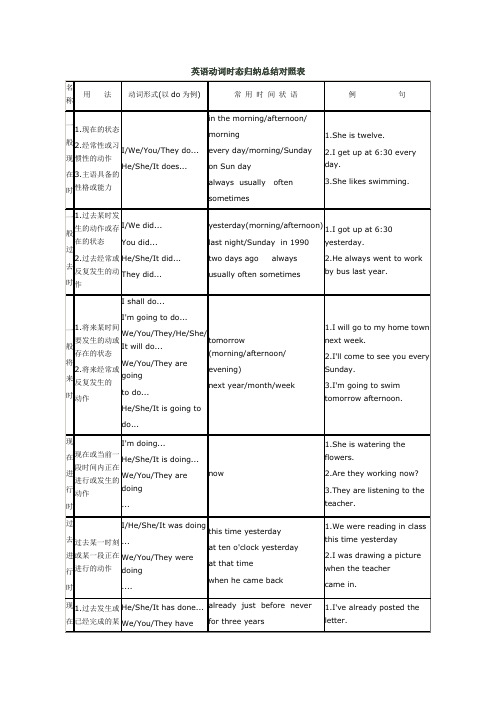
英语动词时态归纳总结对照表英语时态专项练习1、一般现在时。
通常用“usually, often, every day, sometimes”。
一般现在时基本用法介绍一、一般现在时的功能1.表示事物或人物的特征、状态。
如:The sky is blue.天空是蓝色的。
2.表示经常性或习惯性的动作。
如:I get up at six every day.我每天六点起床。
3.表示客观现实。
如:The earth goes around the sun.地球绕着太阳转。
二、一般现在时的构成:肯定句:1).主语+系动词 be(is, am, are )+名词(形容词,介词短语)2) .其他主语+动词原形+其它第三人称单数+动词-s+其它如:I am a boy.我是一个男孩。
We study English.我们学习英语。
Mary likes Chinese.玛丽喜欢汉语。
三、一般现在时的变化否定句:1)主语+ be (is,am,are)+ not +其它。
如:He is not a worker.他不是工人。
2)其他主语+do not(don’t)动词原形+其它I don't like bread第三人称单数+does not(doesn’t)动词原形+其它He doesn't often play.一般疑问句:1)Be(Is,Are) +主语+其它?如:-Are you a student? -Yes. I am. / No, I'm not.2)Do其他主语+动词原形+其它?Does+第三人称单数+动词原形+其它+?注意:遇I/we—you, my—your, some—any.Does she go to work by bike? - Yes, she does. / No, she doesn't.Do you often play football?- Yes, I do. / No, I don't.特殊疑问句:疑问词+一般疑问句。
初中英语动词时态归纳总结对照表
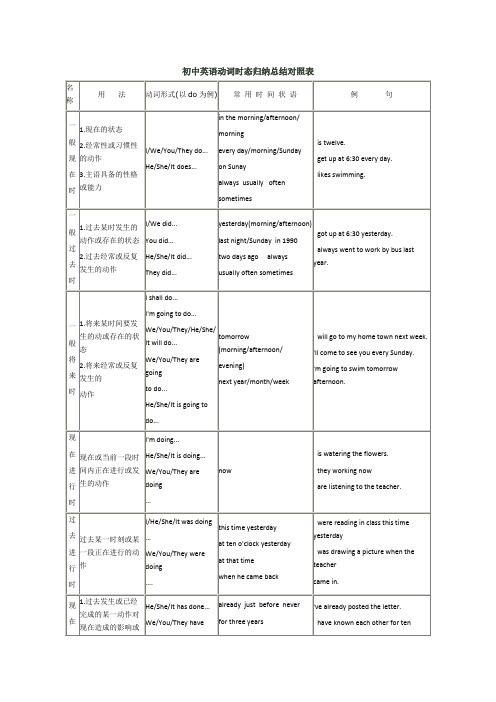
初中英语动词时态归纳总结对照表初中英语时态专项练习1、一般现在时。
通常用“usually, often, every day, sometimes”。
一般现在时基本用法介绍一、一般现在时的功能1.表示事物或人物的特征、状态。
如:The sky is blue.天空是蓝色的。
2.表示经常性或习惯性的动作。
如:I get up at six every day.我每天六点起床。
3.表示客观现实。
如:The earth goes around the sun.地球绕着太阳转。
二、一般现在时的构成:肯定句:1).主语+系动词be(is, am, are )+名词(形容词,介词短语)2) .其他主语+动词原形+其它第三人称单数+动词-s+其它如:I am a boy.我是一个男孩。
We study English.我们学习英语。
Mary likes Chinese.玛丽喜欢汉语。
三、一般现在时的变化否定句: 1)主语+ be (is,am,are)+ not +其它。
如:He is not a worker.他不是工人。
2)其他主语+do not(don’t)动词原形+其它 I don't like bread第三人称单数+does not(doesn’t)动词原形+其它He doesn't often play.一般疑问句:1)Be(Is,Are)+主语+其它如:-Are you a student -Yes. I am. / No, I'm not.2)Do其他主语+动词原形+其它Does+第三人称单数+动词原形+其它+注意:遇I/we—you, my—your, some—any.Does she go to work by bike - Yes, she does. / No, she doesn't.Do you often play football- Yes, I do. / No, I don't.特殊疑问句:疑问词+一般疑问句。
中考复习初中英语动词时态归纳总结范文对照表
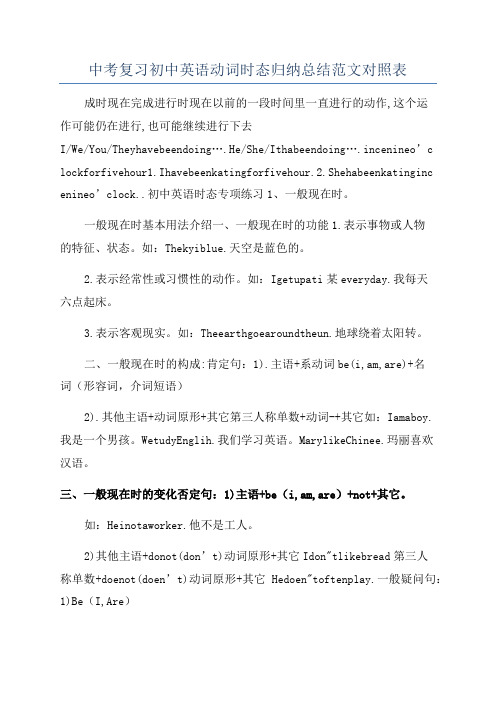
中考复习初中英语动词时态归纳总结范文对照表成时现在完成进行时现在以前的一段时间里一直进行的动作,这个运作可能仍在进行,也可能继续进行下去I/We/You/Theyhavebeendoing….He/She/Ithabeendoing….incenineo’c lockforfivehour1.Ihavebeenkatingforfivehour.2.Shehabeenkatinginc enineo’clock..初中英语时态专项练习1、一般现在时。
一般现在时基本用法介绍一、一般现在时的功能1.表示事物或人物的特征、状态。
如:Thekyiblue.天空是蓝色的。
2.表示经常性或习惯性的动作。
如:Igetupati某everyday.我每天六点起床。
3.表示客观现实。
如:Theearthgoearoundtheun.地球绕着太阳转。
二、一般现在时的构成:肯定句:1).主语+系动词be(i,am,are)+名词(形容词,介词短语)2).其他主语+动词原形+其它第三人称单数+动词-+其它如:Iamaboy.我是一个男孩。
WetudyEnglih.我们学习英语。
MarylikeChinee.玛丽喜欢汉语。
三、一般现在时的变化否定句:1)主语+be(i,am,are)+not+其它。
如:Heinotaworker.他不是工人。
2)其他主语+donot(don’t)动词原形+其它Idon"tlikebread第三人称单数+doenot(doen’t)动词原形+其它Hedoen"toftenplay.一般疑问句:1)Be(I,Are)+主语+其它如:-Areyouatudent-Ye.Iam./No,I"mnot.2)Do其他主语+动词原形+其它Doe+第三人称单数+动词原形+其它+注意:遇I/we—you,my—your,ome—any.Doehegotoworkbybike-Ye,hedoe./No,hedoen"t.Doyouoftenplayfootball-Ye,Ido./No,Idon"t.特殊疑问句:疑问词+一般疑问句。
初中英语动词时态归纳总结对照表
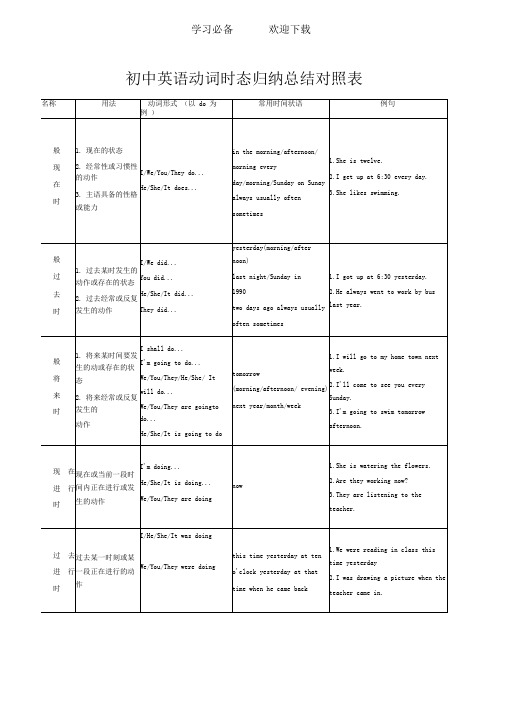
学习必备欢迎下载初中英语动词时态归纳总结对照表初中英语时态专项练习1、 一般现在时。
通常用 “ usually, often, every day, sometimes ”。
一般现在时基本用法介绍 一、一般现在时的功能1. 表示事物或人物的特征、状态。
如: The sky is blue. 天空是蓝色的。
2. 表示经常性或习惯性的动作。
如: I get up at six every day. 我每天六点起床。
3. 表示客观现实。
如: The earth goes around the sun. 地球绕着太阳转。
二、一般现在时的构成 : 肯定句 :1). 主语 +系动词 be(is, am, are )+ 名词(形容词,介词短语)2) . 其他主语 +动词原形 +其它第三人称单数 +动词 -s+ 其它 如: I am a boy. 我是一个男孩。
现 在完成 时过 去完成 时 现 1. 过去发生或已经 完成的某一动作对 现在造成的影响或 结果2. 表示过去已经开 始并持续到现在的 动作或状态过去某一时间前已 经发后的动作或状 态He/She/It has doneWe/You/They haveI/We/You/He/She/I t had done ⋯⋯.already just beforene verfor three years since 1990 this morning these daysby the end of ⋯when+ 一般过去时 before+ 一般过去时1.I've already posted the letter.2.We have known each other for ten years.3.They lived here since 1997.4.Have you ever been to Beijing?1.I had learned 2000 words by the end of last term.2.When I got out,the bus had already left.在完成 进 行 时现在以前的一段时 间里一直进行的动 作,这个运作可能 仍在进行 , 也可能 继I/We/You/They have been doing ⋯. He/She/It has been doing ⋯.since nine o ' clock for five hours1.I have been skating for five hours.2.She has been skating since nine o ' clock..We study English. 我们学习英语。
动词时态总结一览表
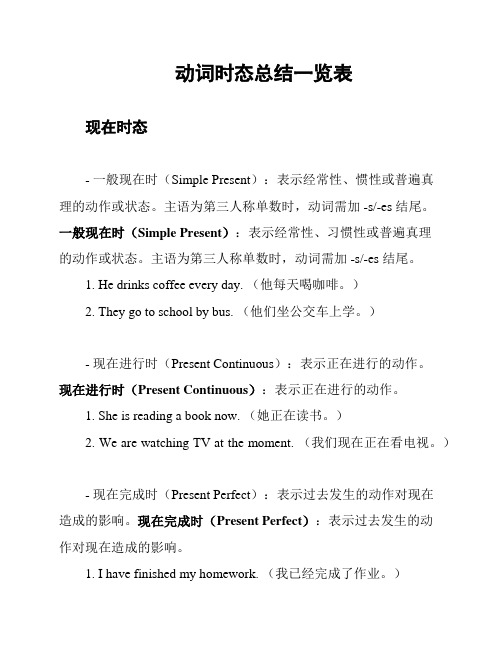
动词时态总结一览表现在时态- 一般现在时(Simple Present):表示经常性、惯性或普遍真理的动作或状态。
主语为第三人称单数时,动词需加 -s/-es 结尾。
一般现在时(Simple Present):表示经常性、习惯性或普遍真理的动作或状态。
主语为第三人称单数时,动词需加 -s/-es 结尾。
1. He drinks coffee every day. (他每天喝咖啡。
)2. They go to school by bus. (他们坐公交车上学。
)- 现在进行时(Present Continuous):表示正在进行的动作。
现在进行时(Present Continuous):表示正在进行的动作。
1. She is reading a book now. (她正在读书。
)2. We are watching TV at the moment. (我们现在正在看电视。
)- 现在完成时(Present Perfect):表示过去发生的动作对现在造成的影响。
现在完成时(Present Perfect):表示过去发生的动作对现在造成的影响。
1. I have finished my homework. (我已经完成了作业。
)2. They have lived here for two years. (他们在这里住了两年了。
)- 现在完成进行时(Present Perfect Continuous):表示动作从过去一直延续到现在。
现在完成进行时(Present Perfect Continuous):表示动作从过去一直延续到现在。
1. They have been playing basketball for two hours. (他们已经打了两个小时的篮球了。
)2. I have been studying English for five years. (我已经研究英语五年了。
)过去时态- 一般过去时(Simple Past):表示过去某个时间发生的动作或状态。
(word完整版)初中英语时态语态总结表-推荐文档

肯定句
主+have/has+V.p.p+其他.
主+have/has+been+V.p.p+其他.
否定句
主+haven’t/hasn’t+V.p.p+其他.
主+haven’t/hasn’t+been+V.p.p+其他.
一般疑问
Have/Has+主+V.p.p+其他?
Have/Has+主+been+V.p.p+其他?
Am/Is/Are+主+V.p.p+其他?
简单回答
Yes,主+do/does. /No,主+don’t/doesn’t.
Yes,主+am/is/are. /No,主+am/is/are+not.
Yes,主+am/is/are. /No,主+am/is/are+not.
Yes,主+am/is/are. /No,主+am/is/are+not.
简单回答
Yes,主+情态动词. /No,主+情态动词+not.
Yes,主+情态动词. /No,主+情态动词+not.
初中英语时态语态总结表
时态名称
主动语态
被动语态
一般现在时
肯定句
主+V/V三单+其他..主+V系+表语.
主+am/is/are+V.p.p+其他.
否定句
主+don’t/doesn’t+V+其他.
最新3.-初中英语动词时态归纳总结对照表
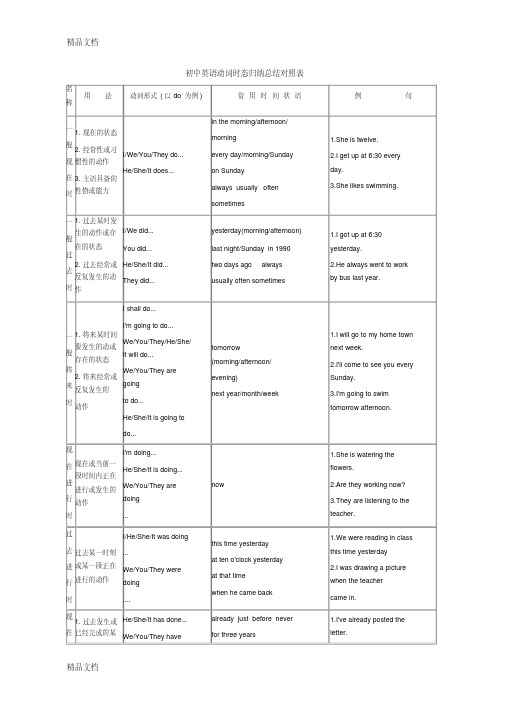
初中英语动词时态归纳总结对照表名称用法动词形式(以do为例) 常用时间状语例句一般现在时1.现在的状态2.经常性或习惯性的动作3.主语具备的性格或能力I/We/You/They do...He/She/It does...in the morning/afternoon/morningevery day/morning/Sundayon Sundayalways usually oftensometimes1.She is twelve.2.I get up at 6:30 everyday.3.She likes swimming.一般过去时1.过去某时发生的动作或存在的状态2.过去经常或反复发生的动作I/We did...You did...He/She/It did...They did...yesterday(morning/afternoon)last night/Sunday in 1990two days ago alwaysusually often sometimes1.I got up at 6:30yesterday.2.He always went to workby bus last year.一般将来时1.将来某时间要发生的动或存在的状态2.将来经常或反复发生的动作I shall do...I'm going to do...We/You/They/He/She/It will do...We/You/They aregoingto do...He/She/It is going todo...tomorrow(morning/afternoon/evening)next year/month/week1.I will go to my home townnext week.2.I'll come to see you everySunday.3.I'm going to swimtomorrow afternoon.现在进行时现在或当前一段时间内正在进行或发生的动作I'm doing...He/She/It is doing...We/You/They aredoing...now1.She is watering theflowers.2.Are they working now?3.They are listening to theteacher.过去进行时过去某一时刻或某一段正在进行的动作I/He/She/It was doing...We/You/They weredoing....this time yesterdayat ten o'clock yesterdayat that timewhen he came back1.We were reading in classthis time yesterday2.I was drawing a picturewhen the teachercame in.现在1.过去发生或已经完成的某He/She/It has done...We/You/They havealready just before neverfor three years1.I've already posted theletter.完成时一动作对现在造成的影响或结果2.表示过去已经开始并持续到现在的动作或状态done...since 1990this morningthese days2.We have known eachother for ten years.3.They lived here since1997.4.Have you ever been toBeijing?过去完成时过去某一时间前已经发后的动作或状态I/We/You/He/She/Ithad done…….by the end of…when+一般过去时before+一般过去时1.I had learned 2000 wordsby the end of last term.2.When I got out,the bushad already left.现在完成进行时现在以前的一段时间里一直进行的动作,这个运作可能仍在进行,也可能继续进行下去I/We/You/They havebeen doing….He/She/It has beendoing….since nine o’clockfor five hours1.I have been skating forfive hours.2.She has been skatingsince nine o’clock..初中英语时态专项练习1、一般现在时。
初中英语动词时态归纳总结对照表

初中英语动词时态归纳总结对照表初中英语时态专项练习1、一般现在时。
通常用“usually, often, every day, sometimes”。
一般现在时基本用法介绍一、一般现在时的功能1.表示事物或人物的特征、状态。
如:The sky is blue.天空是蓝色的。
2.表示经常性或习惯性的动作。
如:I get up at six every day.我每天六点起床。
3.表示客观现实。
如:The earth goes around the sun.地球绕着太阳转。
二、一般现在时的构成:肯定句:1).主语+系动词 be(is, am, are )+名词(形容词,介词短语)2) .其他主语+动词原形+其它第三人称单数+动词-s+其它如:I am a boy.我是一个男孩。
We study English.我们学习英语。
Mary likes Chinese.玛丽喜欢汉语。
三、一般现在时的变化否定句:1)主语+ be (is,am,are)+ not +其它。
如:He is not a worker.他不是工人。
2)其他主语+do not(do n’t)动词原形+其它I don't like bread第三人称单数+does not(doesn’t)动词原形+其它He doesn't often play.一般疑问句:1)Be(Is,Are) +主语+其它?如:-Are you a student? -Yes. I am. / No, I'm not.2)Do其他主语+动词原形+其它?Does+第三人称单数+动词原形+其它+?注意:遇I/we—you, my—your, some—any.Does she go to work by bike? - Yes, she does. / No, she doesn't.Do you often play football?- Yes, I do. / No, I don't.特殊疑问句:疑问词+一般疑问句。
初中英语动词时态归纳总结对照表

初中英语动词时态归纳总结对照表初中英语时态专项练习1、一般现在时。
通常用“usually, often, every day, sometimes”。
一般现在时基本用法介绍一、一般现在时的功能1.表示事物或人物的特征、状态。
如:The sky is blue.天空是蓝色的。
2.表示经常性或习惯性的动作。
如:I get up at six every day.我每天六点起床。
3.表示客观现实。
如:The earth goes around the sun.地球绕着太阳转。
二、一般现在时的构成:肯定句:1).主语+系动词 be(is, am, are )+名词(形容词,介词短语)2) .其他主语+动词原形+其它第三人称单数+动词-s+其它如:I am a boy.我是一个男孩。
We study English.我们学习英语。
Mary likes Chinese.玛丽喜欢汉语。
三、一般现在时的变化否定句:1)主语+ be (is,am,are)+ not +其它。
如:He is not a worker.他不是工人。
2)其他主语+do not(don’t)动词原形+其它I don't like bread第三人称单数+does not(doesn’t)动词原形+其它He doesn't often play.一般疑问句:1)Be(Is,Are) +主语+其它?如:-Are you a student? -Yes. I am. / No, I'm not.2)Do其他主语+动词原形+其它?Does+第三人称单数+动词原形+其它+?注意:遇I/we—you, my—your, some—any.Does she go to work by bike? - Yes, she does. / No, she doesn't.Do you often play football?- Yes, I do. / No, I don't.特殊疑问句:疑问词+一般疑问句。
初中英语动词时态归纳总结对照表(1)
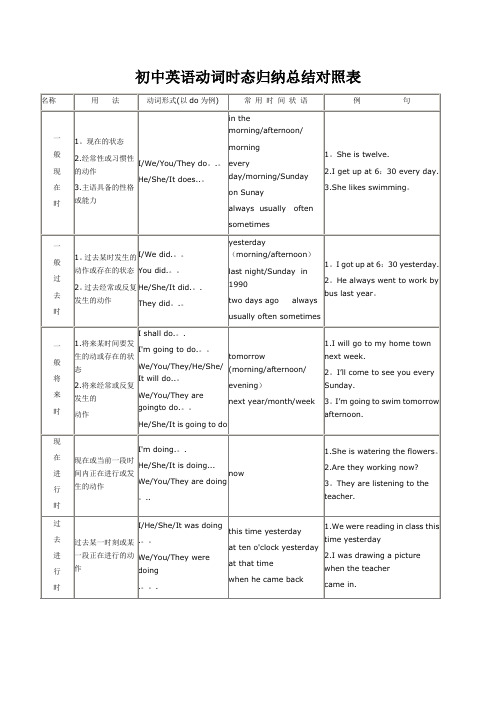
初中英语动词时态归纳总结对照表初中英语时态专项练习1、一般现在时。
通常用“usually, often, every day,sometimes”。
一般现在时基本用法介绍一、一般现在时的功能1.表示事物或人物的特征、状态.如:The sky is blue。
天空是蓝色的。
2.表示经常性或习惯性的动作。
如:I get up at six every day。
我每天六点起床。
3.表示客观现实。
如:The earth goes around the sun.地球绕着太阳转。
二、一般现在时的构成:肯定句:1)。
主语+系动词 be(is, am, are )+名词(形容词,介词短语)2) 。
其他主语+动词原形+其它第三人称单数+动词—s+其它如:I am a boy.我是一个男孩。
We study English。
我们学习英语。
Mary likes Chinese。
玛丽喜欢汉语.三、一般现在时的变化否定句:1)主语+ be (is,am,are)+ not +其它。
如:He is not a worker。
他不是工人.2)其他主语+do not(don’t)动词原形+其它I don't like bread第三人称单数+does not(doesn’t)动词原形+其它He doesn’t often play。
一般疑问句:1)Be(Is,Are) +主语+其它?如:-Are you a student?—Yes。
I am。
/ No, I'm not.2)Do其他主语+动词原形+其它?Does+第三人称单数+动词原形+其它+?注意:遇I/we-you, my—your, some—any。
Does she go to work by bike?- Yes, she does。
/ No, she doesn’t。
Do you often play football?- Yes, I do。
初中英语动词时态归纳总结对照表

初中英语动词时态归纳总结对照表篇一:初中英语动词时态归纳总结对照表初中英语动词时态归纳总结对照表初中英语时态专项练习1、一般现在时。
通常用“usually, often, every day, sometimes”。
一般现在时基本用法介绍一、一般现在时的功能1.表示事物或人物的特征、状态。
如:The sky is blue.天空是蓝色的。
2.表示经常性或习惯性的动作。
如:I get up at six every day.我每天六点起床。
3.表示客观现实。
如:The earth goes around the sun.地球绕着太阳转。
二、一般现在时的构成: 肯定句:1).主语+系动词 be(is, am, are )+名词(形容词,介词短语) 2) .其他主语+动词原形+其它第三人称单数+动词-s+其它如:I am a boy.我是一个男孩。
We study English.我们学习英语。
Mary likes Chinese.玛丽喜欢汉语。
三、一般现在时的变化否定句: 1)主语+ be (is,am,are)+ not +其它。
如:He is not a worker.他不是工人。
2)其他主语+do not(don’t)动词原形+其它 I don't like bread第三人称单数+does not(doesn’t)动词原形+其它Hedoesn't often play.一般疑问句:1)Be(Is,Are) +主语+其它?如:-Are you a student? -Yes. I am. / No, I'm not. 2)Do其他主语+动词原形+其它?Does+第三人称单数+动词原形+其它+?注意:遇I/we—you, my—your, some—any.Does she go to work by bike?- Yes, she does. / No, she doesn't.Do you often play football?- Yes, I do. / No, I don't.特殊疑问句:疑问词+一般疑问句。
初中英语动词时态归纳总结对照表(1)
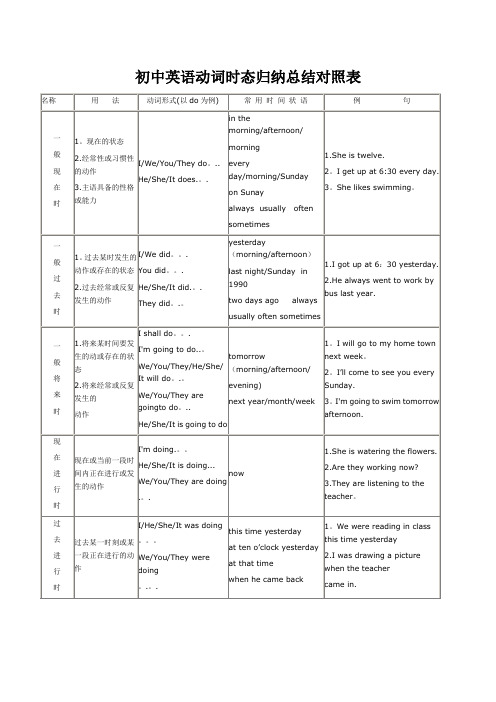
初中英语动词时态归纳总结对照表初中英语时态专项练习1、一般现在时.通常用“usually, often,every day, sometimes”.一般现在时基本用法介绍一、一般现在时的功能1。
表示事物或人物的特征、状态。
如:The sky is blue。
天空是蓝色的。
2.表示经常性或习惯性的动作.如:I get up at six every day。
我每天六点起床。
3.表示客观现实。
如:The earth goes around the sun。
地球绕着太阳转。
二、一般现在时的构成:肯定句:1).主语+系动词 be(is, am, are )+名词(形容词,介词短语)2)。
其他主语+动词原形+其它第三人称单数+动词-s+其它如:I am a boy.我是一个男孩。
We study English。
我们学习英语.Mary likes Chinese.玛丽喜欢汉语。
三、一般现在时的变化否定句:1)主语+ be (is,am,are)+ not +其它。
如:He is not a worker.他不是工人.2)其他主语+do not(don’t)动词原形+其它I don't like bread第三人称单数+does not(doesn't)动词原形+其它He doesn’t often play。
一般疑问句:1)Be(Is,Are) +主语+其它?如:—Are you a student? -Yes。
I am. / No, I'm not。
2)Do其他主语+动词原形+其它?Does+第三人称单数+动词原形+其它+?注意:遇I/we-you, my—your, some—any。
Does she go to work by bike?— Yes, she does. / No,she doesn’t。
Do you often play football?— Yes, I do。
- 1、下载文档前请自行甄别文档内容的完整性,平台不提供额外的编辑、内容补充、找答案等附加服务。
- 2、"仅部分预览"的文档,不可在线预览部分如存在完整性等问题,可反馈申请退款(可完整预览的文档不适用该条件!)。
- 3、如文档侵犯您的权益,请联系客服反馈,我们会尽快为您处理(人工客服工作时间:9:00-18:30)。
中考复习初中英语动词时态归纳总结对照表The document was prepared on January 2, 2021初中英语动词时态归纳总结对照表1、一般现在时。
通常用“usually, often, every day, sometimes”。
一般现在时基本用法介绍一、一般现在时的功能1.表示事物或人物的特征、状态。
如:The sky is blue.天空是蓝色的。
2.表示经常性或习惯性的动作。
如:I get up at six every day.我每天六点起床。
3.表示客观现实。
如:The earth goes around the sun.地球绕着太阳转。
二、一般现在时的构成:肯定句:1).主语+系动词 be(is, am, are )+名词(形容词,介词短语)2) .其他主语+动词原形+其它第三人称单数+动词-s+其它如:I am a boy.我是一个男孩。
We study English.我们学习英语。
Mary likes Chinese.玛丽喜欢汉语。
三、一般现在时的变化否定句:1)主语+ be (is,am,are)+ not +其它。
如:He is not a worker.他不是工人。
2)其他主语+do not(don’t)动词原形+其它I don't like bread第三人称单数+does not(doesn’t)动词原形+其它He doesn't often play.一般疑问句:1)Be(Is,Are) +主语+其它如:-Are you a student -Yes. I am. / No, I'm not.2)Do其他主语+动词原形+其它Does+第三人称单数+动词原形+其它+注意:遇I/we—you, my—your, some—any.Does she go to work by bike - Yes, she does. / No, she doesn't.Do you often play football- Yes, I do. / No, I don't.特殊疑问句:疑问词+一般疑问句。
如:Where is my bike How doesyour father go to work一般现在时用法专练:一、用括号内动词的适当形式填空。
1. He often ________(have) dinner at . Daniel and Tommy _______(be) in Class One.3. We _______(not watch) TV on . Nick _______(not go) to the zoo on Sunday.5. ______ they ________(like) the World Cup二、按照要求改写句子1. Daniel watches TV every evening.(改为否定句)2. I do my homework every day.(改为一般疑问句,作否定回答)3. She likes milk.(改为一般疑问句,作肯定回答)7. I like taking photos in the park.(对划线部分提问)8. John comes fromCanada.(对划线部分提问)三、改错(划出错误的地方,将正确的写在横线上)1. Is your brother speak English __________________2. Does he likes going fishing __________________3. He likes play games after class. __________________4. Mr. Wu teachs us English. __________________5. She don’t do her homework on Sundays. _________________2、现在进行时。
通常用“now/look/listen”.1.现在进行时表示现在正在进行或发生的动作,也可表示当前一段时间内的活动或现阶段正在进行的动作。
2.现在进行时的结构:.肯定句:主语+be(is,am,are ) +动词现在分词-ingeg: I am(not) doing my homework.You/We/They are(not) reading.He/She/It is(not) eating.否定句:主语+be(is,am,are )+not + 动词现在分词-ing一般疑问句:Is(Are)+主语+动词现在分词-ing特殊疑问:疑问词+ be + 主语 + 动词ing3.动词加ing的变化规则1)一般情况下,直接加ing,如:cook-cooking2)以不发音的e结尾,去e加ing,如:make-making, taste-tasting3)如果末尾是一个元音字母和一个辅音字母,双写末尾的辅音字母,再加ing,如:run-running, stop-stopping,swim—swimming4.现在进行时专项练习:一、写出下列动词的现在分词:play________ run__________ swim _________make__________ go_________like________ write________ _ski___________ read________ have_________ sing ________ dance_________ put_________ see________ buy _________love____________ live_______二、用所给的动词的正确形式填空:boy __________________ ( draw)a picture now.2. Listen .Some girls _______________ ( sing)in the classroom .3. My mother _________________ ( cook )some nice food now.4. What _____ you ______ ( do ) now5. Look . They _______________( have) an English lesson .(wash )clothes Yes ,she is .三、句型转换:1. They are doing housework .(分别改成一般疑问句和否定句)2.The students are cleaning the classroom . ( 改一般疑问句并作肯定和否定回答)3.I’m playing the footballin the playground.(对划线部分进行提问)①②3、一般过去时态一般过去时通常用“a moment ago, just now, yesterday, last…”等。
1.一般过去时表示过去某个时间发生的动作或存在的状态,常和表示过去的时间状语连用。
一般过去时也表示过去经常或反复发生的动作感谢。
2.Be动词在一般过去时中的变化:⑴am 和is在一般过去时中变为was。
(was not=wasn’t)My mother ____(be) at home just now.⑵are在一般过去时中变为were。
(were not=weren’t)⑶带有was或were的句子,其否定、疑问的变化和is, am, are一样,即否定句在was或were后加not,一般疑问句把was或were调到句首。
My mother ____(be) at home just now(否定句) ____ you mother at home just now3.行为动词的一般过去时变化规则动词的变化:5.特殊疑问句:⑴疑问词+did+主语+动词原形如: What did Jim do yesterday⑵疑问词当主语时:疑问词+动词过去式如:Who went to home yesterday过去时练习:写出下列动词的过去式 is\am_________ fly_______ plant________ are ________ drink_________ play_______ go________ make ________ does_________dance________ worry________ ask _____ taste_________ eat__________draw________ put ______ throw________ kick_________ pass_______ do________Be动词的过去时练习:A一、用be动词的适当形式填空1. I _______ at school just . He ________ at the camp last . We ________ students two years ago.4. They ________ on the farm a moment . Yang Ling ________ eleven years old last year.二、句型转换1. It was exciting.否定句:________________________________________________一般疑问句:____________________________________________肯、否定回答:__________________________________________2. All the students were very excited.否定句:________________________________________________一般疑问句:____________________________________________肯、否定回答:__________________________________________一、用行为动词的适当形式填空1. He _________ (live) in Wuxi two years . The cat ________ (eat) a bird last night.3. We _______ (have) a party last . Nancy ________ (pick) up oranges on the farm last week.5. I ________ (make) a model ship with Mike yesterday.二、句型转换Hai took some photos at the Sports day.否定句:________________________________________________一般疑问句:____________________________________________肯、否定回答:__________________________________________sang some English songs.否定句:________________________________________________一般疑问句:____________________________________________肯、否定回答:__________________________________________三、中译英1.格林先生去年住在中国。
